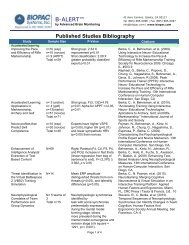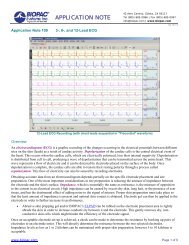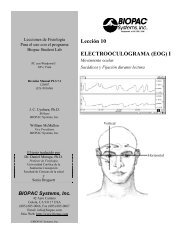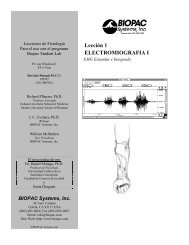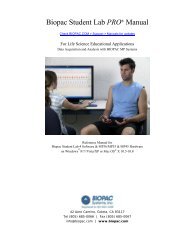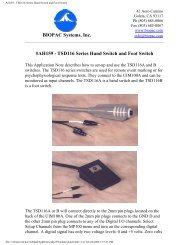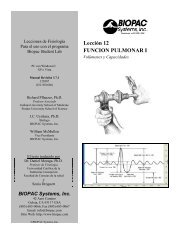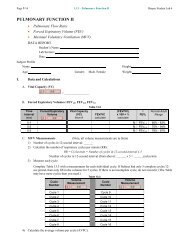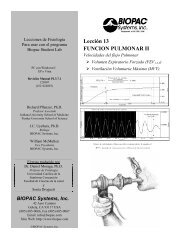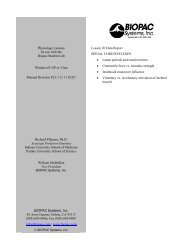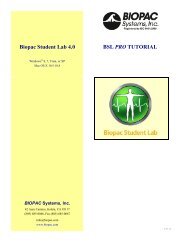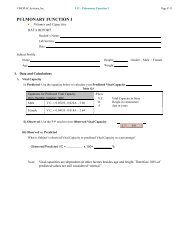BIOPAC MRI catalog
BIOPAC MRI catalog
BIOPAC MRI catalog
You also want an ePaper? Increase the reach of your titles
YUMPU automatically turns print PDFs into web optimized ePapers that Google loves.
For the Life Sciences<strong>MRI</strong> Solutions for Human and Animal Studies• Physiological Data Acquisition Systems• AcqKnowledge Software—automation & specialized <strong>MRI</strong> tools• Remote Monitor• <strong>MRI</strong> Smart Amplifiers• New! Transducers, Electrodes, and Accessories• Human-safe Isolated RF Cable/Filter Systems®
<strong>BIOPAC</strong> provides physiological dataacquisition and analysis systemsspecifically for human and small animal<strong>MRI</strong> life science research applications.<strong>BIOPAC</strong> offers data acquisition systems,<strong>MRI</strong> Smart Amplifiers, transducers, stimulusoptions, electrodes, and leads with advancedsoftware tools for safe data collection, subjectmonitoring, and cleaner physiological signalsin the <strong>MRI</strong> environment.MP Systems and amplifiers are placed in the<strong>MRI</strong> Control Room, and specialized cablesystems optimize data quality with isolatedand RF filtered interfacing between thesubject/<strong>MRI</strong> Chamber and the Control Room.Filter leakage currents and dielectric isolationsatisfy IEC60601-1.Systems include AcqKnowledge software withrich display and monitoring features, plusautomation and scoring routines to provide aflexible solution for life science research.<strong>MRI</strong> Smart Amplifiers incorporateadvanced signal processing circuitry whichremoves spurious <strong>MRI</strong> artifact from the sourcephysiological data.Use the <strong>BIOPAC</strong> Remote Monitor licensedfeature for a simplified view of subject dataacross an IP network on another computer or amobile device. The monitor displays trend dataAmplifier & Transducer Options:• Biopotentials: ECG, EEG, EGG, EMG, EOG• Airflow & Gas Analysis• Blood Pressure—Human and Animal• Differential Pressure• Electrodermal Activity (EDA)• Gating Units (digital trigger)• Force• Laser Doppler Flow• Micro Pressure Measurement• Pulseand current data values. It’s a convenient wayto view the data on other computers in the<strong>MRI</strong> suite.Each MP System includes all the necessaryhardware and software required to turn anycomputer into a powerful data acquisitionworkstation specifically designed for lifescience applications.The MP System will reduce your equipmentsetup time and increase the quality of yourphysiological data. The MP System gives youpublication results with minimum effort.<strong>BIOPAC</strong>’s range of amplifiers further enhancesyour ability to create a system to suit yourapplication requirements. Amplifiers snaptogether and pull apart for simple substitutions.The system is small and easily transported fromthe lab to the <strong>MRI</strong> Control Room.To put together a system for your specificneeds, start with one of our Starter Systems,then add the amplifier modules, transducers,isolated RF cable/filter systems, and electrodesto match your research design.Isolated RF Filtered Cable Systems<strong>MRI</strong> Cable/Filter systems include the cables andisolated RF filtering necessary to safely connectfrom the subject in the <strong>MRI</strong> chamber room tothe amplifier in the <strong>MRI</strong> control room. Systemsare available for biopotential and transduceramplifiers, general and high-level transduceramplifiers, stimulus isolation, and more!Electrodes & LeadsMR Safe and MR Conditional options• SpO2• RespirationReusable and disposable electrodes and leads• Stimulationprovide high quality signals. Gels and accessories• Subject Feedbackalso available.• TemperatureAdditional amplifiers & transducers available for non-<strong>MRI</strong> applications.
MP150 Data Acquisition &Combine the sophistication and performanceof <strong>BIOPAC</strong> data acquisition hardware with thepower and flexibility of AcqKnowledge softwareto customize your acquisition and analysissystem for life science research in the <strong>MRI</strong>.• Remote Monitor — Simplified userinterface to view subject data on anothermachine — bedside monitor display. Trackthe welfare of the subject with alarms towarn when signals fall out of range. Thesystem will work on any device that hasaccess to the same IP based network as theMP150.MP150 data acquisition provides:• High resolution — 16 bit• High speed — up to 400 kHz aggregate• Variable sample rates (analog &calculation channels)• 16 analog inputs and 2 independent analogoutputs• Digital I/O lines (receive/send TTL triggers)• 16 online calculation channels• Ethernet connectivity — fast & efficient• SafetyThe AcqKnowledge software included witheach MP System is a highly interactiveuser-friendly application with intuitivecontrols that lets you instantly view, measure,analyze, and transform data. Perform complexdata acquisition, triggering and analyses usingsimple pull-down menus and dialogs — noneed to learn a programming language ornew protocol.• Acquisition Features — variable samplerates, pause mode, and stimulation designand control. Online analysis settings, filtersand transformations provide real-timerecording feedback.Software runs on Windows OS or Mac OS X.• Display Features — multiple display modes,advanced grid system, journal facility fornote taking, textual event markers, andmeasurement tools. Mouse-over tool tips(for sample rate, channel rate, measurementresults, etc.) help guide application use.• Analysis Features — signal averaging,sophisticated pulmonary integrationroutines, filtering, FFT, histogram, automaticdata reduction, template analysis, peakdetection features, find rate settings, and anequation generator.• Automated Analysis Routines — ECG,HRV, EDA, EMG, EEG, BP, LVP, <strong>MRI</strong>,Pulmonary, and more!• <strong>MRI</strong> optimization routines — artifactremoval, signal blanking, and slew ratelimiter.• <strong>BIOPAC</strong> Developer — Customize andautomate your analysis routines withDeveloper tools including <strong>BIOPAC</strong> BasicScripting, Network Data Transfer, or API.• Support Features — real-time, searchableuser guides (PDF) as well as extensive onlinesupport and training options. Plus, QuickStart template files are included to makeit even easier to start your experiment.Download your AcqKnowledge Demo at www.biopac.com
<strong>MRI</strong> Product Line for Human and Animal Protocols<strong>BIOPAC</strong> has expanded its line of specialized <strong>MRI</strong> products. <strong>MRI</strong> Smart Amplifiers and the<strong>MRI</strong> Cable/Filter systems provide isolated and RF-filtered interfacing between the subject/<strong>MRI</strong>chamber and the <strong>MRI</strong> control room to improve signal quality and optimize safety.With <strong>BIOPAC</strong>’s expanded line of <strong>MRI</strong> Smart Amplifiers and compatible transducers, you canrecord physiological signals such as: ECG, EEG, EGG, EMG, EOG, noninvasive blood pressurefor human and animal, pulse, respiration, SpO2, temperature, electrodermal activity, hand gripstrength (dynamometry), finger twitch, and a variety of pressure-based signals.For small animal cardiovascular and neuro studies, use the TSD104A-<strong>MRI</strong> Pressure Transducer ora Micro Pressure Measurement System to record pressure signals such as BP, LVP, and cranialpressure. Measure microvascular blood perfusion with the Laser Doppler Flow System.Specified electrodes, leads, and stimulus options provide safe data acquisition of physiologicalsignals in the <strong>MRI</strong> environment. Caution is required whenever employing electrode leads andelectrodes in an <strong>MRI</strong> environment—see “Safety Guidelines”online.“MR Safe” Products are non-conducting, non-metallic, and non-magnetic items thatpose no known hazards in all <strong>MRI</strong> environments.“MR Conditional” Products pose no known hazards in a specified MR environment withspecified conditions of use, e.g., field strength or lead configuration.Generally considered, if a transducer is MR Safe or MR Conditional, the transducer signal canbe recorded during <strong>MRI</strong> scanning. Transducer signals are typically high level and slow moving.These two features allow the transducer signal to be easily filtered to remove <strong>MRI</strong> artifact, if any.For MR Declarations and Application Notes on connections, analysis tools, and safety whenrecording physiological data in <strong>MRI</strong> or f<strong>MRI</strong>, go to www.biopac.com.<strong>BIOPAC</strong>’s <strong>MRI</strong> solutions include:Airflow & Gas Analysis Gating (Trigger/Synch)Biopotential Signals Laser Doppler FlowBlood PressurePulseElectrodermal Activity RespirationSpO2StimulationSubject FeedbackTemperature<strong>MRI</strong> Cable/Filter System Interface GuideSample isolated RFfilters and cablesMEC<strong>MRI</strong>-BIOP SystemBiopotential AmplifiersECG100C-<strong>MRI</strong> EMG100C-<strong>MRI</strong>EEG100C-<strong>MRI</strong> EGG EOGMEC<strong>MRI</strong>-DA SystemGeneral-purpose Trans. AmplifierTSD104A-<strong>MRI</strong> TSD117-<strong>MRI</strong>TSD121B-<strong>MRI</strong>MEC<strong>MRI</strong>-HLT SystemHigh-level Transducer AmplifierTSD131-<strong>MRI</strong> TSD115-<strong>MRI</strong>MEC<strong>MRI</strong>-TRANS SystemTransducer AmplifiersEDA100C-<strong>MRI</strong> RSP100CSKT100C PPG100C-<strong>MRI</strong>MEC<strong>MRI</strong>-STMISO SystemSTMISOC/D/E to STM100CCBL207 to STM200PNEUMATIC LINESNo electrical <strong>MRI</strong> Cable/Filterrequired—use DA100C.TSD110-<strong>MRI</strong> TSD137 seriesTSD114-<strong>MRI</strong> TSD237 seriesTSD221-<strong>MRI</strong>
When recording biopotentials in the <strong>MRI</strong>, several scenarios are possible:A. <strong>MRI</strong> Gating: gate the <strong>MRI</strong> using a cardiac signal (ECG, pulse, or BP)and/or a respiration signal — see DTU100 and DTU200/300, page 6.B. Record between periods of <strong>MRI</strong> operation (gradient switching and RF pulsing)with latency periods long enough to acquire the signal of interest.C. Record continuously concurrent with <strong>MRI</strong> operation — see <strong>MRI</strong> App. Notesfor details.<strong>MRI</strong> Smart Amplifiers remove <strong>MRI</strong> artifact from the source physiological data.Signal processors distinguish between the physiological signal and <strong>MRI</strong> artifact asmanifested by gradient switching/RF pulsing during <strong>MRI</strong> sequences, such as anySpin Echo Sequence (e.g., EPI). Since <strong>MRI</strong> Smart Amplifiers remove most <strong>MRI</strong>-related artifactat the source, signals can often be sampled at the same rate as during non-<strong>MRI</strong> recording.Many variables can influence biopotential recording in an <strong>MRI</strong> (lead placement and length,electrode location, <strong>MRI</strong> protocol, etc.). For best performance, use the shortest lead possible.Attention to detail is required to record continuous biopotentials during <strong>MRI</strong> scanning.IMPORTANT! Caution is required whenever employing electrode leads and electrodes inan <strong>MRI</strong> environment—see “Safety Guidelines” online.Radiotranslucent Leads & ElectrodesLeads: LEAD108 (1.8 m), LEAD108A (3.6 m), LEAD108B (15 cm), LEAD108C (30 cm)Electrodes: Disposable EL508 (gel), EL509 (dry) or EL510 (3 x gel with leads)Reusable EL254RT (4 mm) or EL258RT (8 mm)ECG ElectrocardiogramMEC<strong>MRI</strong>-BIOP + ECG100C-<strong>MRI</strong> amp + lead/electrodes• Record small animal ECG with the cable/filter system and radiotranslucent electrodes• For an audible reference of the subject’s heart rate while in the imager, add an ECG alarm (OUT102)Alternatives when looking at real-time BPM, HRV, etc.• MEC<strong>MRI</strong>-DA + DA100C + AFT30-XL tubing (included) through wave guide + TSD110-<strong>MRI</strong>EEG ElectroencephalogramMEC<strong>MRI</strong>-BIOP + EEG100C-<strong>MRI</strong> amp + lead/electrodesEGG Electrogastrogram or EOG ElectrooculogramContact <strong>BIOPAC</strong> for setup options.EMG ElectromyogramMEC<strong>MRI</strong>-BIOP + EMG100C-<strong>MRI</strong> amp + lead/electrodesRecommended alternatives—see Subject Feedback, page 9.• Clench Force: MEC<strong>MRI</strong>-DA + DA100C amp + TSD121B-<strong>MRI</strong>• Hand Response: DA100C amp + TSD114-<strong>MRI</strong>• Facial Twitch/Finger Tap Response: DA100C amp + TSD110-<strong>MRI</strong>• Finger Twitch: MEC<strong>MRI</strong>-HLT + HLT100C interface + TSD131-<strong>MRI</strong>Mouse ECG, HR, Respiration
Airflow & Gas Analysis Gating Systems Microvascular FlowBiopotentials — page 4 Respiration Stimulation — page 10Blood PressureSpO2Airflow & Gas AnalysisSetup: TSD137 or TSD237 series + DA100C amp (flow heads from .05 L/sec to 2.6 L/sec)Transducers consist of a low flow, pneumotach airflow head coupled to a highly sensitive,differential pressure transducer and connect directly to an airflow cannula andnon-rebreathing valve.TSD137 (heated) or TSD237 (unheated; low thermal inertia)MR Conditional: Contains ferrous material—must be clamped down in the safe <strong>MRI</strong> operating area.Gas AnalysisSetup: CO2100C amp + 02100C amp + AFT31-<strong>MRI</strong> gas sampling tubingBlood PressureArterial Blood PressureGeneral Arterial PressureSetup: MEC<strong>MRI</strong>-DA + DA100C amp + TSD104A-<strong>MRI</strong> transducerMicro PressureSetup: MPMS200 control unit + TSD281 (5 cm) or TSD283 (15 cm) transducerNew! This compact, rugged, single-channel fiber optic micro pressure measurementsystem is ideal for small animal physiological pressure monitoring. Provides ananalog output signal in the ±5 V range and has a 250 Hz frequency range; sensortip diameter 0.30 mm (1 French). High resolution system easily interfaces with<strong>BIOPAC</strong> or 3rd-party DAQs and has automatic atmospheric pressure correction.Small Animal Noninvasive Blood PressureSetup: NIBP200A or NIBP250 system + RXCUFSEN9.5/11/13-<strong>MRI</strong> transducerThese NIBP modules incorporate a built-in pump that automaticallyinflates the blood pressure cuff to occlude the vessel. Once the pumpreaches the inflation point it slowly deflates the cuff, providing a lineardrop in pressure. A single pushbutton controls both the inflation anddeflation cycles, making the system very operator friendly.MR Conditional fiber optic cuff/sensor transducers have an 8 m cableand fit 9.5, 11, or 13 mm tail diameters (approx. animal size 100 g -350 g).Oxygen SaturationSetup: OXY300-<strong>MRI</strong> Monitor Subject health or use for <strong>MRI</strong> GatingNew! Noninvasive Vital Signs Monitor provides immediate access to andalarms for pre-, intra-, and post-operative Arterial Oxygen Saturation, HeartRate, and Pulse Distention. Supports heart rates 90-900 BPM for consciousor anesthetized neonatal mice, rats, or other small animals ≤ 500 grams.®Includes MouseOx Plus Monitor, <strong>MRI</strong> sensor cabling with four disposable sensorclips, StarrLink analog output unit, interface cables to <strong>BIOPAC</strong> MP System.
Gating UnitsThe gating unit is placed in the control room with the MP System and amplifiers.Dual-Channel GatingSetup: DTU200 Gating system• Cardio/Respiratory System (DTU200 ) - Dual channel gatingunit for small animal cardiac gating. The unit simultaneouslymonitors a cardiac signal (ECG, pulse, or BP) and a respirationsignal, and provides amplification and signal conditioning.A TTL <strong>MRI</strong> trigger is output for a predetermined number of heartbeats after the respiration cycle. The <strong>MRI</strong> trigger is coincidentwith each heartbeat and incorporates blanking to remove <strong>MRI</strong>artifact to prevent false triggering. The <strong>MRI</strong> is triggered duringthe animal’s quiet time, which minimizes movement and maximizesimage quality. A variety of output signals and conditions can bemonitored during the experiment.Digital TriggerSetup: HLT100C interface module + DTU100 Trigger• Single channel gating unit (DTU100) - provides a TTL trigger pulse from any physiologicalsignal. The system is usually used with either ECG, blood pressure, or respiration signals.See page 7 for more information.Microvascular/Laser Doppler FlowSetup: LDF100C amp + TSD147AL probe (1 m) + TSD148 driver (2 m)For acute preparations inside the <strong>MRI</strong>, use the LDF100C laser Doppler tissue perfusion monitorto measure microvascular blood flow in tissue. The LDF100C amplifier delivers a low powerbeam of laser light down an optical fiber to the tissue being studied; typically, the volume oftissue sampled by the light is in the order of 1mm 3 .RespirationSetup: DA100C amp + TSD110-<strong>MRI</strong> transducer/sensor/tubingFor high-quality respiration signals, place the anesthetized animal on the sensor pad and runthe tubing through the wave guide to attach to the pressure transducer on the DA100C amp.TemperatureStand-alone Fiber-Optic Temperature SystemSetup: FOTS100 + TSD180 fiber-optic temperature transducer. See page 10 for details.Recommended for rectal temperature, due to size.Temperature AmplifierSetup: MEC<strong>MRI</strong>-TRANS + SKT100C amp + TSD202A or E surface transducerThe SKT100C amplifier module measures surface, core, or air temperature with resolutionof 0.0001°C.
Airflow & Gas Analysis Noninvasive Blood Pressure Stimulation — page 10Biopotentials — page 4 Pulse Subject FeedbackElectrodermal Activity — EDA (GSR) Respiration TemperatureGating UnitsSpO2Airflow & Gas AnalysisPerform a variety of tests. Place transducer outside the bore in the <strong>MRI</strong> Chamber Room andrun tubing to connect to the subject and breathing accessories; place amp in Control Room.End Tidal CO2 Setup: C02100C amp + AFT31-<strong>MRI</strong> tubing + AFT35-<strong>MRI</strong> airflow kitAirflow & Lung Volume Setup: DA100C + MEC<strong>MRI</strong>-DA + TSD117-<strong>MRI</strong> ±300 L/min transducer +AFT11A + AFT7-L + AFT35-<strong>MRI</strong> + Optional - add End Tidal: AFT31-<strong>MRI</strong> + CO2100CMetabolic Setup: DA100C + MEC<strong>MRI</strong>-DA + TSD117-<strong>MRI</strong> ±300 L/min transducer +to transducer port A: AFT11A + AFT7-L + AFT35-<strong>MRI</strong> andto transducer port B: AFT11A + AFT7 + AFT15A/B + AFT31-<strong>MRI</strong> + CO2100C and/or O2100CAFT Accessories Go to biopac.com for the complete line of MR Safe options• New! Subject Airflow Kit: AFT35-<strong>MRI</strong> (right-angle port, T-valve, mouthpiece, facemask, and noseclips) provides 6 cm or 12 cm clearance from mouth to f<strong>MRI</strong> coil.• Tubing: 30 mm ID AFT7 (1 m) and AFT7-L (3 m)3.175 mm ID AFT31-<strong>MRI</strong> (10 m, male & female Luer locks, “Y” adapter)• Couplers: AFT11D joins AFT7 tubing segments, AFT11A connects AFT7 to TSD117-<strong>MRI</strong>• Mixing Chamber: AFT15A ( 5 L) or AFT15B (8 L)RespirationFully-pneumatic Respiration Transducer — Recommended MethodSetup: DA100C amplifier + TSD221-<strong>MRI</strong> transducerNew! Measure thoracic or abdominal respiration in the <strong>MRI</strong> withminimal resistance to movement. The TSD221-<strong>MRI</strong> includes therespiration sensor in a mesh strap with self-adhering band (70 cm),a pressure transducer (±12.5 cm H2O), and three cascadablesegments of tubing for up to 15.8 m. Has no ferrous metals orconductive parts and does not require the MEC<strong>MRI</strong>-DA.Respiratory Effort TransducerRespiration dataSetup: MEC<strong>MRI</strong>-TRANS + RSP100C amp + TSD201 transducerThe respiratory effort transducer measures changes in thoracic or abdominal circumference thatoccur as the subject breathes. Uses adjustable Velcro strap to fit a wide range of subjects.Gating UnitsDigital Trigger / R-Wave Sync DTU100 Setup: HLT100C interface module + DTU100 TriggerTrigger an <strong>MRI</strong> System with the occurrence of the R-wave present in ECG, respiratory data or bloodpressure for gating purposes. This external hardware unit accepts data from any pulsatile analog outputassociated with an MP System and converts it into a TTL-compatible trigger to trigger an <strong>MRI</strong>.• Trigger timing resolution is excellent because it is controlled solely by the real time analogreference signal and is independent of the OS and associated communication delays.Cardio/Respiratory Gating DTU300 Setup: DTU300 Gating SystemUse the DTU300 to trigger the <strong>MRI</strong> on the basis of two physiological signals, such as a cardiac signal(ECG, pulse, or BP) plus a respiration signal. See page 6 for details.
Noninvasive Blood Pressure - Wireless Monitoring SystemSetup: HLT100C interface module + NIBP-<strong>MRI</strong>The NIBP-<strong>MRI</strong> provides real-time, beat-to-beat pressuremeasurement values during magnetic resonance imaging. Thesystem tracks systolic and diastolic blood pressure (using Pulse-Decomposition Analysis technology). The device analyzes thetiming and amplitudes of the primary left ventricular ejectionpulse as well as the arterial pulse reflections, at the thumb, middlephalange of the middle finger, at the wrist, or on the upper arm.PulsePulse - Photo PlethysmographSetup: MEC<strong>MRI</strong>-TRANS + PPG100C-<strong>MRI</strong> amp + TSD200-<strong>MRI</strong> transducerThe TSD200-<strong>MRI</strong> transducer is sensitive to Blood Volume Pulse (BVP) via photo-plethysmographicmethods. Use it to record the blood volume pulse pressure waveform. It’s primarilydesigned for finger or toe attachment, but can be taped to other body locations with TAPE1.Pulse - Pressure PadSetup: DA100Camp + AFT30-XL tubing (included) throughwave guide + TSD110-<strong>MRI</strong> transducerThe TSD110-<strong>MRI</strong> consists of a differential pressure transducer,sensor, and tubing. Use it to record pulse and pulse rate—itrequires no electrical connections between <strong>MRI</strong> control andchamber rooms and works on a number of body locations.Affix to finger or major pulse point with TAPE1.Oxygen SaturationNIBP-<strong>MRI</strong> dataElectrodermal ActivitySetup: MEC<strong>MRI</strong>-TRANS + EDA100C-<strong>MRI</strong> amplifier + lead/electrodesRecord EDA inside the <strong>MRI</strong>. Use AcqKnowledge software filters to improve the quality of theEDA signal, if required, and provide automated analysis.Electrodes•Disposable: For excellent EDA responses, <strong>BIOPAC</strong> recommendsEL509 dry disposable electrodes with GEL101 andLEAD108 (1.8 m), LEAD108A (3.6 m),LEAD108B (15 cm), or LEAD108C (30 cm).•Reusable: Disposable electrodes are recommended, but reusableEDA dataTSD203 electrodes will also work for skin conductance.Pulse dataSetup: OXY-<strong>MRI</strong> New! Use as stand alone system or connect to MP SystemSpO2 amplifier with fiber-optic finger sensor for adult human pulse oximetry.Pulse Rate Range: 18–321 BPM, Saturation Accuracy (Arms): 70–100% ± 2 digits.Includes isolation adapter and cables to connect to an existing HLT100C forMP Systems. Additional finger sensors available: OXY-<strong>MRI</strong>-SENSOR.
Subject Feedback<strong>BIOPAC</strong> offers a range of subject feedback devices for use inside the <strong>MRI</strong>.Clench Force Setup: MEC<strong>MRI</strong>-DA + DA100C amp + TSD121B-<strong>MRI</strong> transducerUse TSD121B-<strong>MRI</strong> hand dynamometer to measure clench force. The lightweight,ergonomically designed transducer provides direct readings in kilograms orpounds. The isometric design improves experiment repeatability and accuracy.Hand Response Setup: DA100C amp + TSD114-<strong>MRI</strong> transducerUse TSD114-<strong>MRI</strong> Pump Bulb Transducer when the subject has to give either a monotonicallyvariable or on/off response. The subject holds the bulb in one hand and squeezes to give aresponse. Use two bulbs for more complicated responses. The bulb is attached to a length oftubing that connects to the included pressure transducer.Response PadSetup: DA100C amp + TSD110-<strong>MRI</strong> transducerMount the TSD110-<strong>MRI</strong> pressure pad in the scanner so that the subject can tap it to respond(monotonically variable or on/off) to a stimulus. Use multiple transducers for complex applications.Consists of differential pressure transducer, sensor, and tubing. See Pulse on page 8 for transducer details.The multi-purpose assembly can also be used to measure small pressing forces (like pinchingfingers together) for Parkinson’s evaluations, human facial expressions (including startle blinkresponse, smiling, frowning, etc.), or spacing and pressure between teeth coming together.Finger Twitch/PositionSetup: MEC<strong>MRI</strong>-HLT + HLT100C interface + TSD131-<strong>MRI</strong> transducerUse TSD131-<strong>MRI</strong> to record finger twitch responses or finger position from humansubjects in the <strong>MRI</strong>. Conforms to the shape of the finger and attaches via Velcro straps.Tri-Axial Accelerometry Setup: HLT100C interface + TSD109C2-<strong>MRI</strong> transducer (includes MEC<strong>MRI</strong>-7)Use this very small tri-axial accelerometer to capture subtle gestures, slow movements, ortapping reponses. The high level output transducer (±5 G) is 33 mm x 28 mm x 9 mm andprovides three outputs, simultaneously measuring acceleration along the X-, Y- and Z-axes,with frequency response from DC to 500 Hz. Place on fingers, hand, toes, foot, etc.Variable Assessment Setup: MEC<strong>MRI</strong>-HLT + HLT100C interface + TSD115-<strong>MRI</strong> transducerThe TSD115-<strong>MRI</strong> incorporates a slide control with graduated scale that allows the user to gaugehis/her subjective response to a variety of different stimuli. The transducer is lightweight and fitseasily into the subject’s hand or lap.TemperatureFiber Optic Response Devices<strong>BIOPAC</strong> offers a range of fiber optic response devices that interface withthe MP150 and a variety of visual presentation systems; call for details.Temperature Amplifier Setup: MEC<strong>MRI</strong>-TRANS + SKT100Camp + TSD202 probeThe SKT amplifier module measures surface or air temperature with resolution up to 0.0001°C.• TSD202A - Very small, fast response probe.• TSD202E - Slower response; suitable for body temp.
Stand-alone Fiber-Optic Temperature SystemSetup: FOTS100 + TSD180 or TSD181 FO temperature probeTo interface with UIM100C, add RCA-3.5 mm cable (CBL101, not included).System uses advanced technology with 62.5 µm core fiber and 50 Hz samplingrate. Excellent linearity and accuracy for long-term reliability and repeatability.Not photonic intensity based. No local heating due to fiber construction. Suitable forMR field strength of 3T and lower—contact <strong>BIOPAC</strong> for options for 7T and higher.• FO Rectal temp probe (0.42 mm dia., 8 m): TSD180• FO Surface temp probe (3 mm dia., 8 m): TSD181STIMULATIONFor Comprehensive Safety Guidelines, see “Safe Use of Electrical Stimulators” online.Stimulation—Constant Current/Constant VoltageSetup: MEC<strong>MRI</strong>-STMISO + STMISOC/D/E stim isolationadapter + STM100C stimulator + lead/electrodesUse the stimulator to deliver a variety of electrical stimulationparadigms. AcqKnowledge software provides single pulse, pulsetrains, and arbitrary waveform output options.0.42 mmStimulation—Unipolar Wide PulseSetup: MEC<strong>MRI</strong>-STMISO + CBL207 + STM200 stimulator + lead/electrodesUse the stimulator for any preparation or subject, including painand stress studies that require lower voltages and wider pulse widths.Trigger the stimulator from the MP150 or a visual presentationsystem (see below). Use for high-energy nerve or muscle stimulation.Stimulation ElectrodesUse disposable or reusable electrodes for subject stimulation.• Disposable: EL509 dry electrodes plus GEL104 + LEAD108 Series electrode leads• Reusable: EL254RT/258RT plus GEL104 + ADD200 Series collars• Gel: GEL104 salt-free and chloride-free electrically conductive gelVisual PresentationSuperLabSetup: STP100W Stimulus Presentation SystemThe STP100W can present visual stimuli or auditory stimuli, and simultaneously (1msresolution) send trigger signals to an MP150 for data synchronization and collection purposes.Optional: STIMTRACKER universal marker interface, provides digital trigger info fromSuperLabE-Prime, DirectRT, MediaLab, Presentation, etc.Setup: STP100C isolated digital interface with CBL110C (optional: splitter CBL110C-Y)Connect to the computer’s parallel printer port to send digital I/O info.3 mm
High-Quality PhysiologicalData for <strong>MRI</strong> Studies• <strong>MRI</strong> Smart Amplifiers• Biopotentials• Airflow &Gas Analysis• Blood Pressure• Differential Pressure• Electrodermal Activity• Gating/Trigger Units• Force• Laser Doppler Flow• Micro Pressure• Noninvasive Blood Pressure• Respiration••SpO2Stimulation• Subject Feedback• Temperature• Visual PresentationRegistered to ISO 9001:200842 Aero CaminoGoleta, CA 93117®



